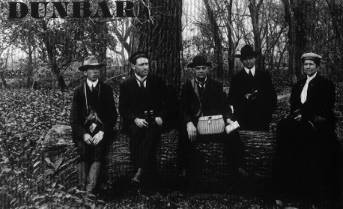
A town was founded in 1856 at the intersecting property lines of four farms, whose owners were John Dunbar, Thomas Dunbar, Mrs. J. Wilson, and John McGinley. A settlement began as a ranch house and barn owned by Thomas Wilson, which was a stopping place for the overland stage. Green cottonwood lumber was brought in by oxen from Nebraska City, and soon there were houses and many businesses. Initially called "Wilson," a post office was commissioned under that name on May 16, 1866. In 1867 plans for the Midland Pacific Railway from Nebraska City to the Union Pacific in Hamilton County were announced. However, rails were not immediately laid, and it was April 1871 before trains were operating as far as Lincoln. For a very short time, the name of the station was changed to "Dennison." (Both were probably rejected since Wilson and Dennison were names of other Nebraska towns.) On April 2, 1874, the name was changed to "Dunbar," for John Dunbar, oldest resident of the community. The town celebrated its centennial in 1956 -- 100 years from its initial founding. The great Dunbar train robbery occurred on January 11, 1887. A passenger train carrying $17,000 in silver bullion was deliberately derailed one-half mile north of Dunbar. The men responsible for the wreck, which killed the train's engineer and injured many others, were caught. Called "the Crime of the Century," one man was hanged and the other was given ten years of hard labor. When the town was established, a school was organized to help it grow. In time, a secondary school was added, with the first graduating class in 1893. There have been three buildings since then. The present school, built in 1915, is still at the top of the hill, now part of the Syracuse-Dunbar-Avoca district. John Reese, well-known author for the Saturday Evening Post , is a graduate of Dunbar High. By the early 1920s Dunbar's population was well over 300. There were two or more hotels, banks, and elevators, and numerous shops. There was also a cement plant, a cheese factory, and "day service" for freight to and from the depot. "The Dunbar Review" was published weekly, there were four churches, and a park where a two-day picnic was held annually. The dance hall was called "the Hyppodrome." In addition to lodge rooms, the Masonic Hall was used for traveling medicine shows, movies, and the junior and senior class plays. Dunbar had a large stockyard next to the railroad and many cattle were driven in to be shipped to market. The story goes that after a successful round-up, one cowboy decided to ride his horse through the swinging doors of one of the local establishments, which caused a great uproar. Dunbar experienced a devastating flood on May 8, 1950. Two lives were lost when seven homes, the dance hall, and a filling station were washed away. The depot, many homes, and several Main Street businesses received heavy damage. Most were not replaced, which was a further loss to the town. In August 1965 the Highway 2 bypass was opened around Dunbar. The 1.7 mile curve, which routed traffic around one of the steepest main streets in the Midwest, benefited through traffic, but caused a hardship for the stores and stations in town. Highway 67, which runs north-south, still carries a fairly heavy line of traffic through town. In recent years, our town celebrates "Dunbar Days" on the second weekend in August. In 1991 the town purchased Christmas decorations -- first time ever. Street signs were also erected. Dunbar's highest population, 336, was recorded in 1940. Present-day Dunbar has a population of 172, the majority of whom are employed in Nebraska City, Syracuse, or Tecumseh. The area supports a volunteer fire department, a post office, a sizable co-op elevator, several independent businesses, and the Dun-Bar. The BN trains still go by, but the depot is a thing of the past. Dunbar is still a pretty little town with many large trees. We have a Presbyterian Church and, in addition to our well-kept and attractive older homes, there are some newer ones. Dunbar may be short in area of population than before, and there are fewer business, but our town is long on "nice town to live in." By Helen Roos, Box 85, Dunbar, NE 68346. |
| Home | Contact |
© NEGenWeb
